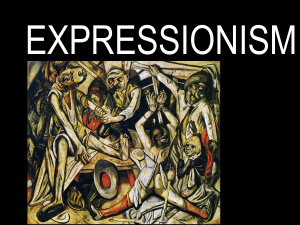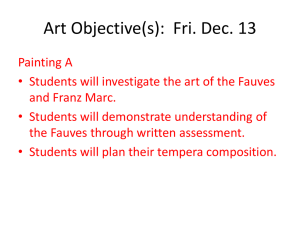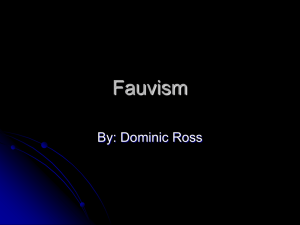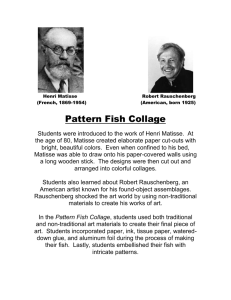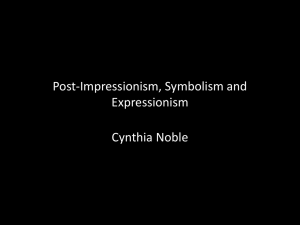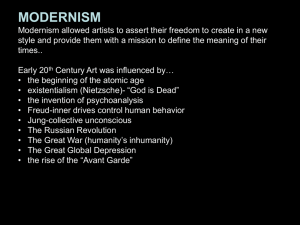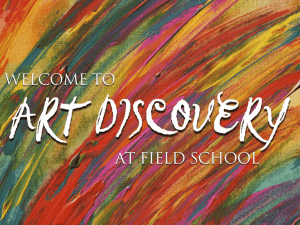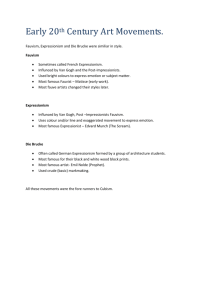06 expressionism
advertisement
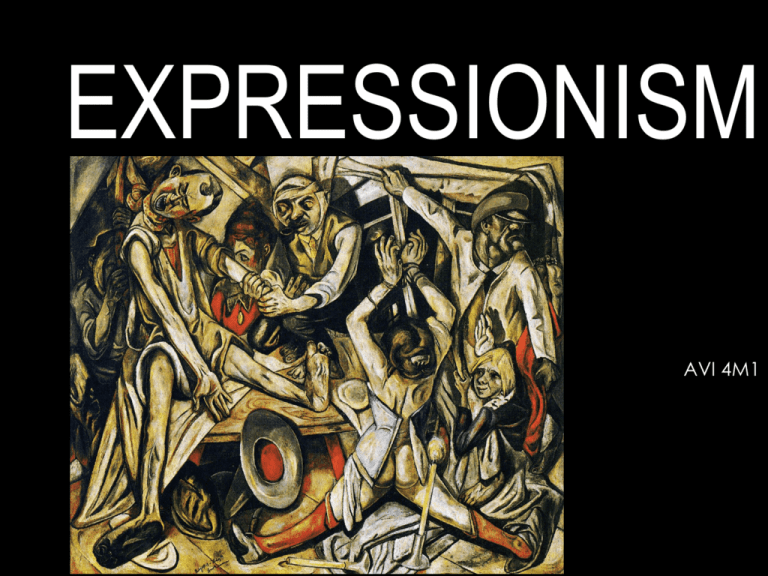
EXPRESSIONISM AVI 4M1 Some review: Modernism had 4 key characteristics: #1: Shock of the New Abstraction is essential #2: #3: Cult of the Genius #4: Honesty of Materials There were 3 basic approaches to abstraction: 1 Intellectual Abstraction, as seen in Cubism There were 3 basic approaches to abstraction: 2 Emotional Abstraction, as seen in Expressionism There were 3 basic approaches to abstraction: 3 Psychological Abstraction, as seen in Surrealism Today, we’re looking at this one: 2 Emotional Abstraction, as seen in Expressionism Post Impressionists Van Gogh and Gauguin… influenced “Expressionism” Expressionism took on many forms, but there were 3 common characteristics: 1. Personal expression of the artist is the most important thing; 2. Vivid, exaggerated colours; 3. Distortion of shapes to communicate emotional states. Some early Expressionists include Edvard Munch: Edvard Munch, The Scream, 1893 … and pre-Cubist Pablo Picasso: Pablo Picasso, The Old Guitarist, 1903 4 Early Expressionist movements: #1 The Fauves, 1905 Means: “Wild Beasts” - originally an insult. Frenchwith my HEART “I paint Expressionists and my LOINS, not bothering about style!” -Vlaminck Vlaminck, Self Portrait Influenced by Gauguin! The Fauves: Henri Matisse Henri Matisse, The Dance, 1909 The Fauves: Henri Matisse Henri Matisse, The Green Line, 1905 Matisse was interested in using colour to achieve a ‘new truth’; pictorial harmony; beauty! The Fauves: Henri Matisse Henri Matisse, The Red Turban, 1907 Matisse was not interested in expression through “the violent gesture”. The Fauves: Henri Matisse Henri Matisse, Panel with Mask, 1947 Matisse’s late work were largescale collages of cut-out coloured paper. The Fauves: George Rouault George Rouault, The Clown, 1907 Rouault’s work was often overtly religious, exploring Man’s inhumanity to Man. Early Expressionist movement #2: Der Brucke, 1905 Means: “The Bridge” in German. “Oooo – look at me! I’m all PRIMiTIVE and NAKED! How uncivilized!” Der Brucke: Ernst Kirchner Kirchner, Self Portrait as a Soldier, 1915 Kirchner’s group sought to escape the chains of civilization by making “primitive” art in order to be more fully human. Der Brucke: Ernst Kirchner Kirchner, Eigendruck They did rough woodcuts, influenced by old German prints, Oceanic art and Gauguin. Der Brucke: Ernst Kirchner Kirchner, Self Portrait with Model, 1910 Their art tried to express artistic struggle and social isolation… … by using shocking colour, shocking distortion & shocking subjects Early Expressionist movement #3: Franz Marc, The Yellow Cow Der Blaue Reiter, 1910 Means: “The Blue Rider” in German. “Woo Hoo! I am so playful and spiritual! I’m a yellow cow! Der Blaue Reiter : Kandinsky Vassily Kandinsky, Composition 7 “Form itself is meaningless unless it is the expression of an artist’s inner necessity and everything is permitted to serve this end.” - Kandinsky Der Blaue Reiter : Kandinsky Vassily Kandinsky, Painting with Three Spots Kandinsky searched for a common spiritual basis of all the arts… … music, visual art, poetry and religion. Der Blaue Reiter : Kandinsky Vassily Kandinsky, Composition 8 Kandinsky’s later, graphic style Der Blaue Reiter : Franz Marc Franz Marc, The Fate of the Animals, 1913 Marc foreshadowed W.W.1; and died in the war shortly thereafter. Der Blaue Reiter : Paul Klee Paul Klee, The Twittering Machine, 1922 Klee approached art with the playfulness of a child, experimenting with mixed media and automatic drawing. Der Blaue Reiter : Paul Klee Paul Klee, Ad Parnassum, 1932 Early Expressionist movement #4: New Objectivity, 1916 Shocked by the suffering caused by W.W.1; German artists; vicious often satirical art focusing on the ills of society. “Whoa! Are we ever angsty and intense! Is that your best poker Otto Dix, Three Card Players face? New Objectivity : Otto Dix Otto Dix, Dr. Mayer-Hermann, 1926 Dix did exaggerated, unflattering portraits of various types of people from German society. New Objectivity : Otto Dix Otto Dix, Portrait of Dancer Anita Berber, 1925 Dix did exaggerated, unflattering portraits of various types of people from German society. New Objectivity : Otto Dix Otto Dix, Skull: The War, 1924 Dix was a shellshocked veteran of WW1 and made brutal depictions of the horrors of war. New Objectivity : Max Beckmann Max Beckmann, The Night, 1919 Beckmann illustrated the chaos and violence of post-war Germany. Grunewald, The Eisenheim Altarpiece, 1512-1516 Many German Expressionists continued the tortured German Renaissance tradition. Many German Expressionists continued the tortured German Renaissance tradition. Otto Dix, War Triptych, 1929 - 1932 New Objectivity : George Grosz George Grosz, Toads of Property, 1921 Grosz mocked the powerful and showed distain for the wealthy. New Objectivity : George Grosz George Grosz, Fit for Active Service, 1917 Grosz mocked the powerful and showed distain for the wealthy. New Objectivity : Kate Kollwitz Kollwitz, The Mothers and the War, 1919 Kollwitz was a master printmaker. Her work shows sympathy for the underprivileged, particularly women and children. New Objectivity : Kate Kollwitz Kollwitz, The Peasant War, 1921 German Expressionism was almost extinguished with the rise of Fascism and the election of the Nazi party in the 1930s. Their work was labeled “degenerate” by the Nazis and put on display in mocking traveling shows. Many Expressionist artists left Germany (Beckmann, Grosz), were silenced (Kollwitz) or were killed. The influence of Expressionism was wide-spread and is still a very popular style of art-making today. Francis Bacon, Head Surrounded by Sides of Beef Expressionism: Key Dates: 1905 – present Key Artists: Henri Matisse Ernst Kirchner Vassily Kandinsky Paul Klee Otto Dix Kate Kollwitz Expressionism: Influenced by: - Van Gogh and Gauguin: distortion of realism to express personal, emotional and spiritual states Expressionism: Characteristics: 1. Personal expression of the artist is the most important thing; 2. Vivid, exaggerated colours; 3. Distortion of shapes to communicate emotional states. Fin.
